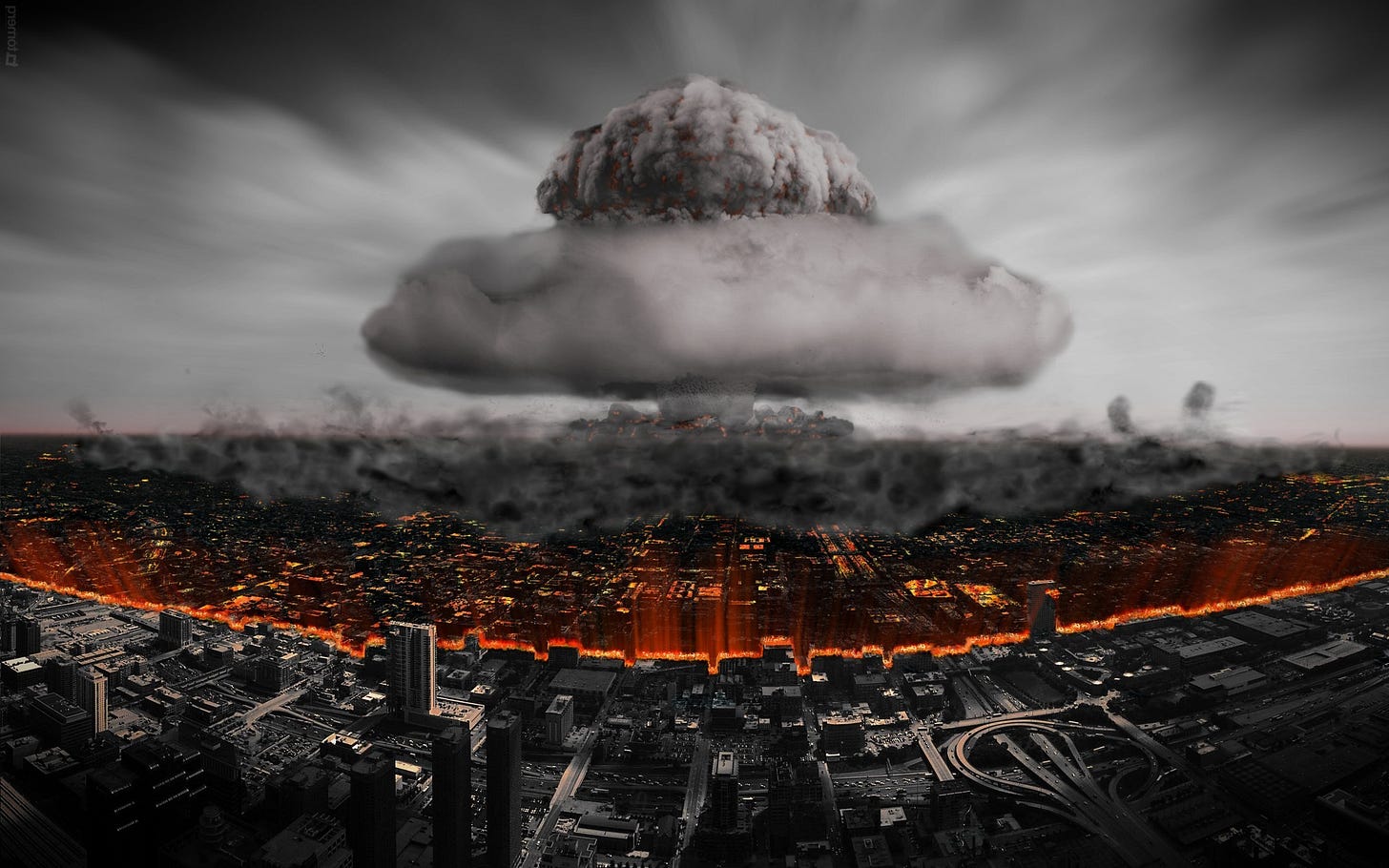(Updated July 2024 and June 2025)
N.B. This essay is theologically grounded, not politically aligned. It draws on biblical prophecy to explore the metaphysical dimensions of nuclear deterrence and the Gog-Magog conflict. No endorsement is implied for any nation-state, ideology, or faction — nor does it take a position on the recent U.S. attacks on Iran’s nuclear facilities. A YouTube video posted yesterday, June 22, by actor Morgan Freeman is included in the footnotes. Freeman suggests these attacks may have awakened a renewed sense of unity within the Ummah — the global Muslim community.
Introduction
Amidst proliferating conflict in the Middle East and decaying diplomacy, the theory of nuclear deterrence remains both cornerstone and curse. It rests on a fragile presumption — that no actor, however embattled, would risk mutual annihilation. Yet the current instability driven by mounting tensions between Israel and Iran demands a sober reexamination of that assumption.
Some now view the escalating crisis as the potential ignition point for the long-foretold Gog-Magog war — a regional conflagration with global consequences.
This essay revisits the logic of deterrence through historical precedent, firsthand experience, and the ominous implications of Israel’s Samson Option. We find ourselves once again contemplating the unthinkable — not in abstract, but on the television and computer screens of eyewitness reality.
Perspective
Nuclear deterrence relies on a Faustian bargain — the promise of mutual annihilation and a presumption that rational players won't cross the ultimate line. That terrifying math somehow kept the peace during the Cold War's closest calls, specifically the 1962 Cuban Missile Crisis.1
Here we are again, watching yet another Middle East conflict edge humanity closer to the unthinkable — forced to recalculate the odds of Armageddon with technological variables the Cold War never faced nor envisioned.
As a radio announcer back then, I vividly recall the palpable fear, the relentless monitoring of the AP teletype for the ding-ding-dinging bells that signaled an urgent story. All the while, the haunting question persisted: Would reason prevail or would the demonic fires of chaos consume us all?
Today, some 60 years later, as we revisit similar uncertainties, the lessons from that pivotal moment in history remain urgently relevant. Or do they? In 1962, Presidents Kennedy and Khrushchev walked us back from the brink. Today, leaders in Washington and European capitals aligned with Kiev and Tel Aviv seem to be walking directly toward it.
It's widely acknowledged, though unofficially confirmed, that Israel commands a substantial nuclear arsenal, with estimates that range from 200-300 warheads.
This robust nuclear capability underpins Israel’s strategy of deterrence, which signals a readiness to employ these weapons if an existential threat arises — a posture reminiscent of the position adopted by the U.S. Military's Joint Chiefs during the tense days of October 1962. General Curtis LeMay, U.S. Air Force Chief of Staff, was ready to pull the trigger.
The Cuban Missile Crisis of 1962 represented deterrence theory in its purest form: two superpowers, each capable of destroying the other, engaged in a carefully choreographed pas de deux of escalation and restraint.
Today's Middle Eastern sizzling powder keg presents a more complex equation, one in which regional nuclear capabilities, asymmetric warfare, and overlapping religious and geopolitical narratives create multiple pathways to Armageddon.
Referencing my career again, in 1968, I was War News Editor of the American Forces Vietnam Network headquartered in Saigon. There had recently been a battle in the Mekong Delta at Bến Tre, located some 80 clicks south of Saigon. The hamlet was destroyed by U.S. Forces during the Tet Offensive. A U.S. officer was quoted having told the AP’s Peter Arnett, “We had to destroy the village in order to save it.”
Invocation of such an insane “scorched Earth” strategy evinced during the Tet Offensive sets the stage for our discussion of Israel's Samson Option. This option, too, is intended as deterrence. The doctrine purportedly states that should Israel find itself face-to-face with an imminent existential threat, it is prepared, nay even compelled, to launch its nukes.
One wonders if the poor villagers of Bến Tre had possessed that capability, if they might have done the same.
Regardless of how Americans may “feel” about the latest Middle East conflagration, of this fact we may be certain: Israel will not allow itself to be annihilated. Nor will Iran.
Samson
The name refers to the ancient Biblical figure of Samson, an Israelite judge who pushed apart the pillars of a Philistine temple, bringing down the roof on himself and the thousands of Philistines who had captured him, as recounted in the Book of Judges (16:30).
By analogy, the ‘Samson Option’ describes Israel "bringing down the temple" upon itself and its enemies, were it deemed to be on the verge of annihilation.
Simply put, the Samson Option encapsulates Israel's nuclear doctrine — a commitment to massive retaliation, if necessary, to deter any existential threat.
The Samson Option has never been officially confirmed by the Israeli government — Israel has a policy of ambiguity which, Hersh argues, deters aggressors without technically violating international law. Israel neither confirms nor denies it possesses nuclear weapons, although it’s widely understood that it maintains a substantial at-the-ready arsenal.
Some high-profile individuals, such as Martin van Creveld, a professor of military history at the Hebrew University in Jerusalem, have alluded to the Samson Option. He asserts that the very existence of such a drastic measure acts as a deterrent against attacks on Israel.
The Samson Option has been the subject of considerable debate and criticism. While it may serve as a deterrent, it is also a deeply problematic and risky strategy. This is because of the catastrophic implications of its use — not just for Israel and the Middle East, but potentially for the entire world. The use of nuclear weapons in the Middle East (by any nation) might ignite WWIII.
In 1962, had the Soviet ships transporting missiles and other weaponry to Cuba run America’s naval “embargo” (blockade), the outcome likewise could have triggered WWIII. That expectation was as palpable then as it is now.
Seymour Hersh's 1991 book, “The Samson Option,” delves into the history of Israel's nuclear capability, focusing on how the country cultivated its nuclear program as a last-resort in the event of an existential threat. Below is a summary of Hersh’s key findings.
Key Points
Secrecy and Deception — Hersh outlines how Israel managed to keep its nuclear program under wraps for years, despite being under close international scrutiny.
International Collaboration — The book details Israel's collaborations with countries like France to develop its nuclear program, often in secret, even as it was officially denying the existence of any such program.
The Role of Individuals — Important figures in the Israeli government and military, such as David Ben-Gurion, Shimon Peres, and others, are discussed in terms of their roles in making the nuclear program a reality.
Ambiguity as Policy — As I mentioned, Israel has never officially confirmed nor denied its nuclear capabilities, a policy of ambiguity that, according to Hersh, serves its interests by deterring potential aggressors without explicitly breaking international laws or norms.
Deterrent or Offensive — Hersh discusses the ethical and strategic implications of Israel having a nuclear arsenal. Is it purely for deterrence, or could it be used preemptively? The Samson Option raises complex ethical questions.
International Reactions — The book explores how other nations, particularly the United States, have reacted to rumors and evidence of Israel's nuclear capabilities, balancing political and strategic considerations. His thorough exploration travels back to Lyndon Johnson’s presidency and the ascendance of the Military Industrial Complex, which continues to grow like a canker sore.
The Existential Question — At the heart of the Samson Option is the existential question for Israel — how far it is willing to go to survive in a region where it has so many adversaries?
Wars and rumors of wars thrust topics that once seemed remote into sudden relevance. While the Samson Option is considered a last-resort scenario, its theoretical and strategic implications, while valuable for assessing broader issues in international relations, must now be factored into today’s Middle East strategic calculus.
Two distinct, yet equally pivotal, analyses vis-à-vis 1962 are required to fully appreciate the potential trajectory of recent events.
The first is mundane and geopolitical. In 1962, the U.S. could not permit nuclear missiles under an enemy’s control 90-miles from Miami — the Monroe Doctrine explicitly forbade it. The Israeli-Iranian war evokes a second, less common metaphysical analysis, which is equally important, in my opinion. It appeals to the authority and messianic prophecies contained in the Torah and Christian Bible.
We refer specifically to Christian Zionists’ desire to “hasten the eschaton,” which refers to actions taken to bring about the end of the world and the Messianic Age. Misguided attempts to "hasten the eschaton" can lead to dangerous or manipulative behavior, including promoting conflict or neglecting social justice in favor of an imminent apocalyptic scenario.
An example are plans to construct the Third Temple in Jerusalem, supported by Christian Zionists and Jewish groups like HaTenu'ah LeChinun HaMikdash (The Movement to Rebuild the Holy Temple).
The Gog - Magog War
We wrote in greater detail about this prophecy in a previous essay [here]. Briefly, the current Middle East war could rapidly escalate into a regional conflict. If this happens, we might reasonably expect Israel to invoke the Samson Option as it would be faced with a clear existential threat.
A coalition potentially led by Turkey and Iran — encompassing the Axis of Resistance, with potential organizational support from the Muslim Brotherhood and the possible involvement of states such as Iraq, Syria, Lebanon, Yemen, Egypt, Ethiopia, Sudan, Libya, and even Azerbaijan — reflects the current potential for an Islamic alliance against Israel and the awakening of the Ummah. This coalition also mirrors the list of nations waging war against Israel as identified in interpretations of the Gog and Magog prophecy.2
We don’t know if Iran has nuclear weapons. For thirty years they’ve been only two weeks away, according to the ever-clanging neocon war tocsins. Pakistan stepped in to provide Iran with second-hand deterrence by promising to nuke Israel if they nuked Iran.
It’s believed that Israel also possesses a neutron bomb, also known as an enhanced radiation weapon (ERW). This weapon is a type of low-yield (tactical) thermonuclear weapon. We don’t know if ERWs fall under the aegis of the Samson Doctrine. Its design aims to maximize lethal neutron radiation in the immediate vicinity of the blast while minimizing the physical power of the blast itself to protect infrastructure.
Unlike traditional nuclear weapons, which primarily cause blast and heat damage, a neutron bomb intentionally allows the neutron release generated by nuclear fusion to escape the weapon. This neutron burst is more effective at penetrating enemy armor, making it more lethal as a tactical weapon with anti-personnel attributes.
The concept was originally developed by the United States in the late 1950s and early 1960s. ERWs were first deployed for anti-ballistic missile systems, where the burst of neutrons would prevent nearby warheads from exploding properly.
Biblical prophecy, particularly in the book of Ezekiel, describes a future confrontation known as the Gog-Magog conflict, in which God decisively intervenes in human affairs. Some see the emergence of weapons capable of unprecedented destruction as a possible fulfillment, or at least a foreshadowing, of these prophetic visions.
The prophecy leaves little doubt — God is prepared to assert his will in the Gog-Magog conflict.
Then I will knock the bow out of your left hand, and cause the arrows to fall out of your right hand. You shall fall upon the mountains of Israel, you and all your troops and the peoples who are with you; I will give you to birds of prey of every sort and to the beasts of the field to be devoured. You shall fall on the open field; for I have spoken, says the Lord God.
Ezekiel 39:3-5
World War III
On Rational Spirituality’s Substack homepage, the navigation bar has a shortcut to essays that mention “Medugorje,” where the Virgin Mary has been appearing since 1981.
Regardless of one’s beliefs about Marian apparitions, I spent some time living in Medugorje in the 1990s, where I became friends with two of the six visionaries. Based on my many visits there, which spanned two decades, I can vouch for the authenticity of the events I witnessed.
For those curious about how preternatural phenomena might align with science, I find that quantum physics — and specifically Rational Spirituality’s theory of Quantum Coalescence (also linked on the homepage) — presents a compelling framework for understanding apparitions. There is, I believe, a natural consonance between quantum physics and spirituality.
On July 12, 1982, Mary stated that “World War III will not take place.” While that revelation can be reassuring on one hand, it begs interpretation on the other.
Could the same cosmic forces that once destroyed Atlantis — yet ensured a remnant survived to carry civilization forward (our own ancestors) — be compelled to intervene again, driven by our persistent inability to live in peace?
If so, such an event might fulfill Mary’s prophecy not by preventing war through peace, but by obliterating the possibility of war altogether — precluding what would otherwise be humanity’s devolution into a third world war.
Indeed, what if the only way to save civilization were again to destroy it?
Would that I could channel the testimony of the ‘wise old man’ archetype who lived in Bến Tre, South Vietnam, in 1968 — someone who witnessed what war saves and what it costs.

I encourage anyone unfamiliar with the 1962 Cuban Missile Crisis to watch Thirteen Days, an excellent documovie (2020) starring Kevin Costner.
In Islam, the Ummah refers to the global community of Muslims, a concept that transcends national, ethnic, and racial boundaries. It signifies a sense of brotherhood and shared identity among all believers in Islam, united by their faith and the teachings of the Quran and the Prophet Muhammad.






Listening to Morgan Freeman's speech, I wonder what kind of Ummah we will face. Will we face one who wants peace, or will we face one that wants war and will destroy anything in it's way.
Since Islam is authoritarian in nature, I wouldn't be surprised if the Muslim nations allied with communist countries
Will 40 Muslim nations bring us into a nuclear war?
As much as Morgan Freeman deserves the esteem in which he is held, he is completely wrong about Islam finding a sudden voice or Islam being a sleeping giant.
How counter factual can he be?
We have put up with on going Islamic genocide across many African nations for decades. We have put up with Islamic issues marching in our streets calling for death to America and Jews and Israel. We have put up with Pakistanis slaughtering Hindus.
We have read with disgust how Islamic countries treat non-moslems as well as moslem girls and women.
And now Israel, after years of Iranian proxy wars against their people strikes Iran to reduce the danger. And now *that* is "Israel striking first"?
What contemptible ignorant clsptrap.